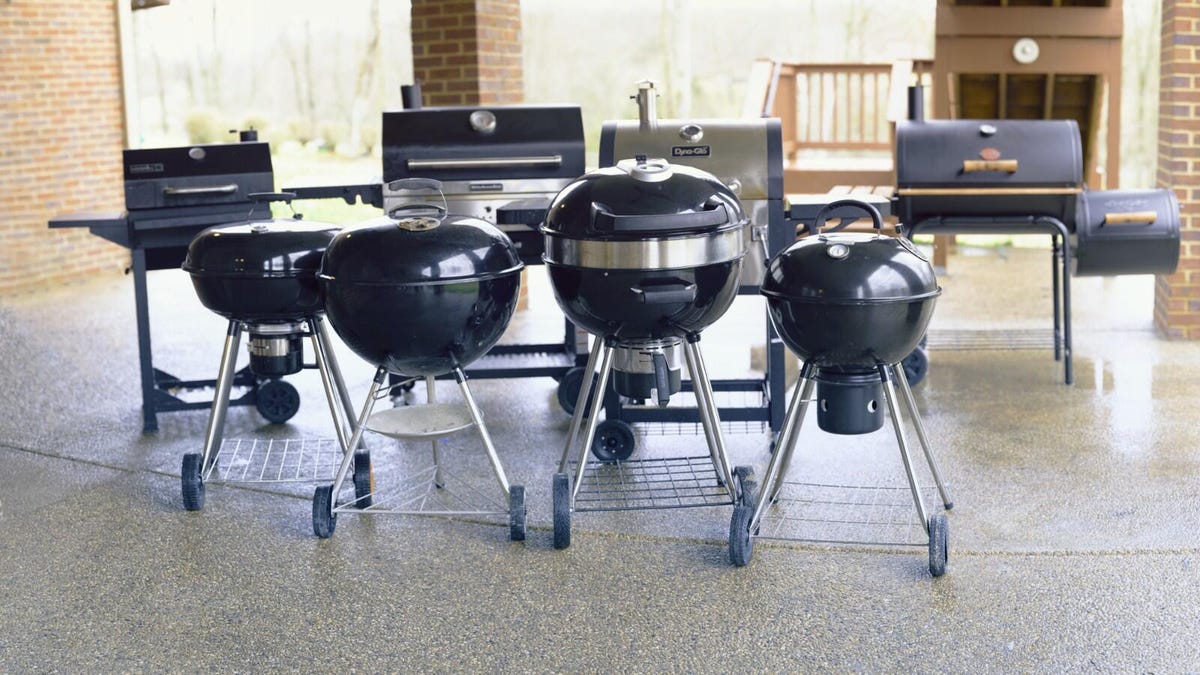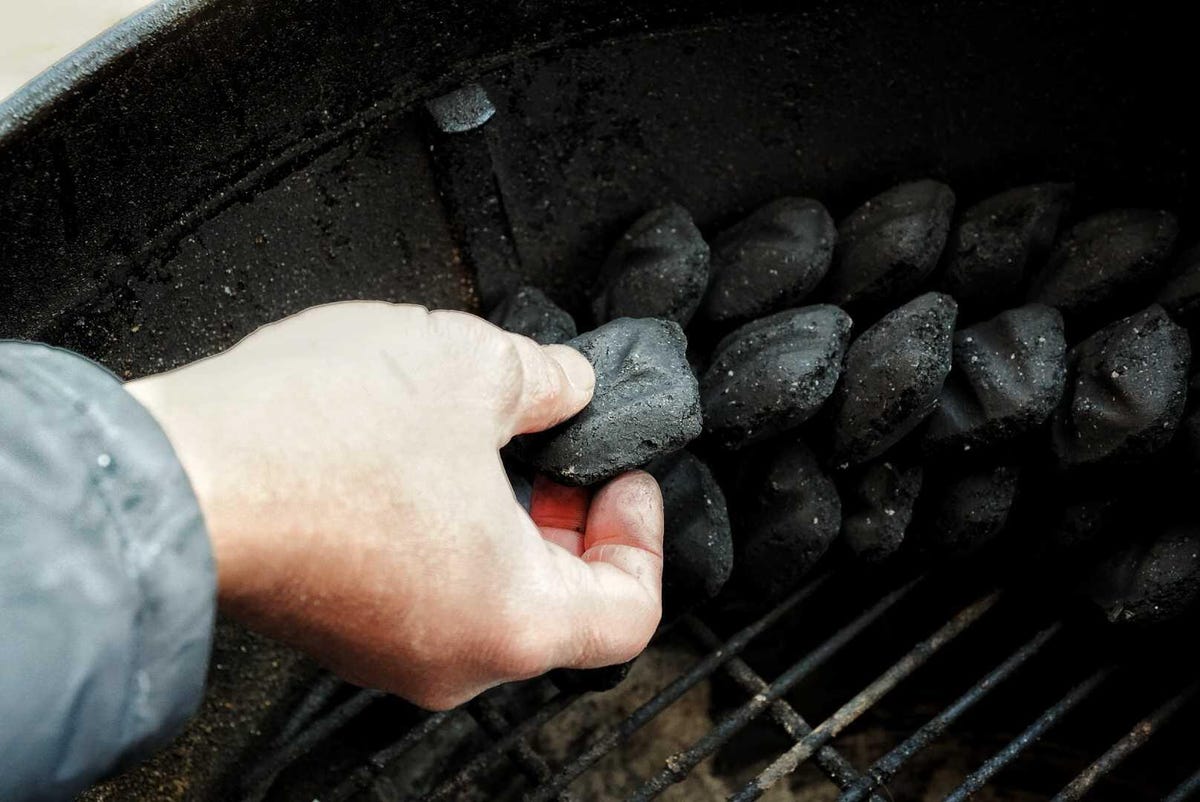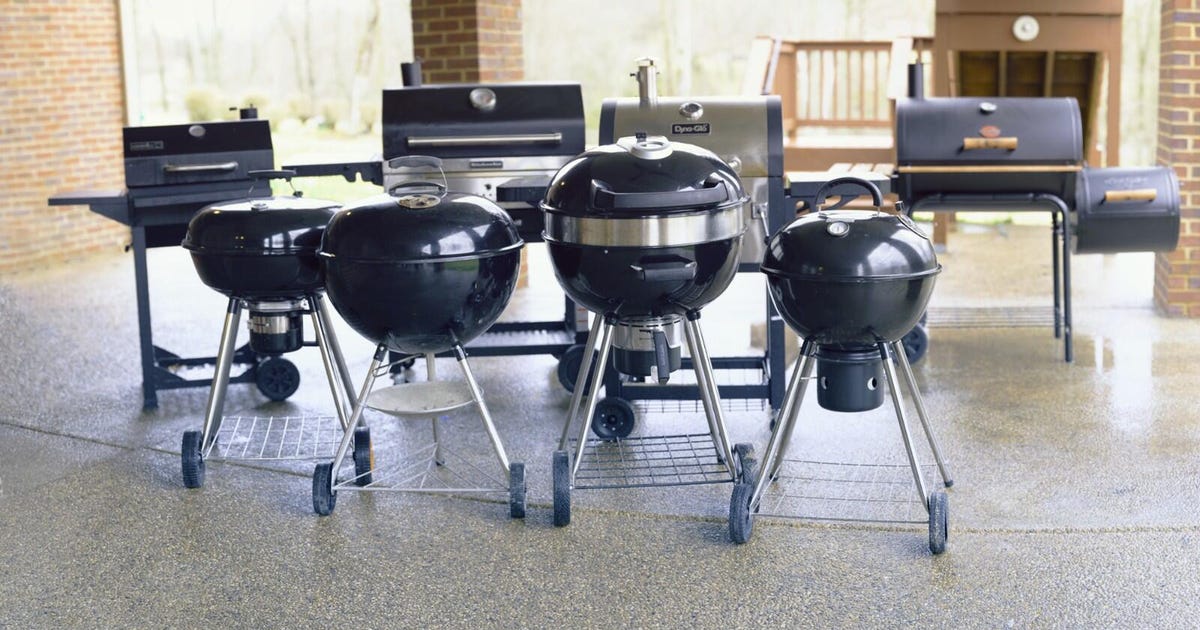In this article:
Visions of tasty backyard cookouts never cease no matter what season it is. It’s always a great time to up your outdoor cooking game by using the best charcoal grill you can find. A charcoal grill might sound less luxurious than a gas grill, but when it comes to flavor, the best charcoal grills absolutely compete.
Charcoal grills are also often more affordable than their gas counterparts, making them a good option for tight budgets and beginner grillers. They’re typically easier to set up than a gas grill, too. All you need for charcoal grilling is a lighter, a bag of charcoal and your favorite ingredients. In no time you’ll be reaping the rewards of an easy meal with true smoky flavor.
From cart-style to kettle-style, feature-filled grills to ones that offer the bare minimum, we tested nine charcoal grills with chicken, ribs and steak to find out which are the best bets for your next backyard barbecue. We’ll update this list periodically.
Best charcoal grills
Tyler Lizenby/CNET
At $139, Weber’s original, kettle-style charcoal grill continues to stand the test of time. In our high-heat searing tests, Weber delivered the best balance of seared exterior and medium-rare interior steak. The Weber kettle grill gave us tasty chicken too, with crispy chicken skin. The Weber can also smoke low and slow at a rock-steady cooking temperature. That translated to seriously flavorful ribs.
Simple construction means there aren’t too many parts to assemble or too many features to handle while cooking. A vent on the lid controls airflow and a well-designed ash tray beneath the Weber grill facilitates easy cleanup.
We tested the 22-inch Weber charcoal grill in black, but Weber also offers an 18-inch version of its original kettle design. There are certainly fancier and more expensive grills to use for cooking, but for a balance of affordability and quality, you can’t go wrong with this classic. This is the best charcoal grill overall.

Chris Monroe/CNET
The Nexgrill Cart-Style Charcoal Grill is a compelling alternative to the Weber, especially if you prefer a cart-style backyard cooker. That design gives you a handy side tray and more cooking surface room. In fact, at 572 square inches, this updated larger grill has even more cooking space than the previous version, which offered 390 square inches. It’s also a lot compared with the Weber’s 363-square-inch cooking area.
The Nexgrill definitely gets hot enough to create a nice sear, but you do have to work a little harder than you do with the Weber to avoid overcooking your meat. We recommend the reverse searing method for thicker cuts. You can also raise the Nexgrill’s adjustable charcoal tray basket to its highest position. That way you’ll get a seared crust as quickly as possible.
In our medium, indirect-heat chicken tests, the Nexgrill delivered flavorful, juicy meat as a close second to the Weber. Ribs were tender, juicy and done in just under 5 hours. And this updated model, when we used the charcoal snake method, demonstrated temperature control almost as good as the Weber.
Cart-style grills aren’t for everyone. They’re bulkier, the assembly is more involved and you’ll likely need more fuel to keep the larger space at a high temperature. Our results, however, were almost as good as with the kettle-style Weber, so if you’re interested in a cart-style charcoal BBQ, this is your best bet.

Tyler Lizenby/CNET
How we test
Testing charcoal grills requires a lot of hands-on cooking, and your results will obviously vary based on your technique and ingredients, among other factors. Depending on the season and how your charcoal grill is set up, your experience cooking and grilling will likely be very different from ours. For example, a kettle-style charcoal grill left in the July sun all day will run a lot hotter than it will in the cooler spring months.
Also, a note about grill thermometers. None of the hood thermometers built into these grills mirrored the temperatures recorded by our own thermocouples and data software. It’s not uncommon for grill thermometers to read high, so we recommend keeping an oven thermometer or Bluetooth thermometer handy while you’re grilling, either for your meat or for the grill’s temperature itself.
High-heat searing with steak
To test high heat, we seared two steaks on each grill. We measured charcoal in a chimney by grams, and in a ratio for that grill’s specific surface area. We lit the charcoal inside the chimney, letting it burn until the smoke dissipated and the coals began to turn grayish-white, then put the charcoal into the grill. After the grill was heated up for 10 minutes, the steaks were ready to hit the grill grate.

Once the grates were hot, we put two steaks on each grill.
Tyler Lizenby/CNET
We placed two steaks on each grilling grate near the center and seared them for five minutes before flipping them over and searing for another five minutes. With a good, reliable grill, this will give you a steak with a seared outside and a medium rare to medium center. If you prefer meat that’s more well done, you can extend the cooking time, or sear and finish cooking in an oven.

High-heat searing was our first grill test.
Tyler Lizenby/CNET
The best charcoal grill for steak searing in our lineup was the Weber Classic Kettle. The steak had nice grill marks while keeping a medium doneness on the inside. The worst was our Tacklife review unit, which didn’t hold much heat and didn’t sear while cooking. The steak on that grill needed an additional five minutes to get to a temperature of 135 F, the minimum for medium rare.
Chicken and indirect, medium heat
Next, we tested each grill’s medium heat cooking capability by roasting whole chickens. The trick here is to keep the grills at a hot enough temperature to cook a chicken for upwards of two hours.
For our tests, each grill gets a full chimney of lit charcoal and a 6-pound chicken opposite the coals for indirect heat.

Each grill got a chimney of hot charcoal.
Tyler Lizenby/CNET
Cooking over charcoal takes longer than cooking with a gas grill, and we typically need to add more fuel during cooking to keep our grills above 350 degrees F for the full duration. Our favorite bird from this batch was the one cooked on the Weber, though it was a tough call. The bird cooked on the Nexgrill cart-style grill came in right behind, a close second in terms of flavor and texture.

We cooked chicken over indirect heat until it reached an internal temperature of 165 degrees F.
Tyler Lizenby/CNET
The difference between the two was largely in the crispiness of the skin, with the Weber producing the superior results. Meat from the Nexgrill was delicious, with just a bit more flavor than the Weber. Between them, I’d say it largely depends on your budget and what style of grill you prefer for other meats like burgers or steak. Weber certainly had the superior sear in that category.
Low-and-slow ribs
Our last test is grilling barbecued ribs, specifically baby back pork ribs. This style of cooking requires strict temperature control over a period of multiple hours. Ideally, a quality charcoal grill (or any smoker) will keep its fire humming along close to 225 degrees F for as long as possible.

Stack your charcoal briquettes in two rows of two deep along the inner wall of the grill.
Tyler Lizenby/CNET
First, we set up each grill for a low-and-slow burn, using the charcoal snake method. In the case of kettle models, we arrange coals in a semicircle around the grill’s inner wall. The charcoal briquettes (Kingsford Blue) form a line two coals wide and two coals deep. We also drop a few chunks of smokewood on top of the snake (aka fuse). On cart-style grills, we modify the snake to run in right angles to match their rectangular-shaped fireboxes.
Next, we light each grill’s snake at one end of the chain with five lit briquettes (tumbleweed fire starters work, too). We set all air vents on each grill (top and bottom) to the halfway-open position. Lastly, we place one rack of ribs on each grill for indirect cooking, with the meat not sitting directly above the coals.
The classic Weber Kettle grill treated racks of ribs right.
Brian Bennett/CNET
The Weber was the undisputed king in this test. No other grill in this group could match the rock-solid temperature control of this iconic cooker. Readings from our own thermocouples, plus a digital pit thermometer, confirmed this. Throughout the Weber’s 6-hour, 32-minute cook time, the grill’s internal heat levels never strayed beyond 25 degrees of our target, 225 degrees F. In fact, most of the time the temperature hovered between 220 degrees F and 230 degrees F. As a result, ribs cooked in the Weber came out tender, juicy and full of smoky flavor.
Ribs cooked on the Napoleon grill came out tasty, though with bark that was a little dry.
Brian Bennett/CNET
The Napoleon grill was the second best in this test. Interior temperatures had a greater swing, jumping up to 300 degrees F during periods of cooking. Its rack of ribs was ready in a short 4 hours, 30 minutes. While its ribs came out tender and juicy overall, the exterior bark had a few burnt spots.
Ribs cooked on the Nexgrill had lots of bark but were juicy and tender inside.
Brian Bennett/CNET
We noted similar temperature performance from the Nexgrill, along with similar rib results. Cooking ribs low and slow on the Nexgrill required just 4 hours, 30 minutes. Its rack came out well too, though like the Napoleon, its bark was more pronounced than what the Weber produced.
Our rib experience with a few of the other grills was far from ideal. The Tacklife was particularly bad. At times, the inside of this grill hit temperatures as high as 400 degrees F. And sadly, the ribs it produced came out burned, charred and overdone.
Other grills we’ve tested
The CNET Smart Home editors have been serving up grill data for a few years now. In addition to the models we recommend above, here are the other charcoal grills we’ve tested:
- KitchenAid Cart-Style Charcoal Grill: KitchenAid’s $239 cart-style charcoal grill has heavy-duty cast iron grates as well as two foldable side trays for extra workspace. It didn’t wow us in any of our tests, but wasn’t noticeably bad either.
- Cuisinart Kettle Charcoal Grill: This 18-inch kettle-style grill costs $87 and includes all the basic features you’d expect. It couldn’t beat the Weber for classic kettle cooking, but it’s a solid second choice for an affordable kettle-style grill.
- Dyna-Glo Heavy Duty Charcoal Grill: This cart-style model from Dyna-Glo is pricier at $233, and has killer looks but only fair performance.
- Masterbuilt Gravity Series 560: This $497 cart-style model from Masterbuilt is pricey but unique. It burns charcoal but controls its fire and heat levels electronically like a pellet smoker. It performs well too, though it could be more fuel-efficient. The Masterbuilt’s hardware isn’t weatherized against rain either. Read our full review.
- Royal Gourmet CD1824A 24-inch Charcoal Grill: At $200, this cart-style BBQ grill is very affordable. It also offers a decent amount of cooking space when you count its upper warming rack. Apart from chicken that was nicely done, its performance was mediocre. It also burned through more charcoal than other grills.
- Expert Grill Heavy Duty 24-inch Charcoal Grill: Similar to the Royal Gourmet model, the $107 Expert Grill is an affordable cart-style outdoor cooker. However, with 372 square inches of cooking space, the Expert Grill offers a little less room to maneuver. And though it seared our test steaks nicely, it took over 2 hours to roast chicken. That’s much longer than the 1 hour, 20 minutes or so the typical charcoal grill takes.
Best charcoal grill FAQs
Is it worth buying a charcoal grill?
A quality charcoal grill is certainly worth the investment. Due to their comparably simple construction, they tend to cost less than a similarly sized gas or pellet grill. Another powerful draw of these grills is the intense smoky flavor they create in the food they cook. They’re versatile too since they can use either traditional charcoal briquettes or lump charcoal as fuel.
Is it better to grill with charcoal or wood?
Each fuel type has its particular strengths and weaknesses. Charcoal briquettes and lump charcoal are easier to ignite and keep lit than ordinary firewood. That said, charcoal (especially in briquette form) produces a lot more ash than hardwood. And if you plan to cook low and slow we suggest adding a few chunks of hardwood to your charcoal pile. This brings about more smoke flavor in barbecue meat like pork ribs, pork butt and beef brisket.
More outdoor and grilling goodness
#Charcoal #Grill








